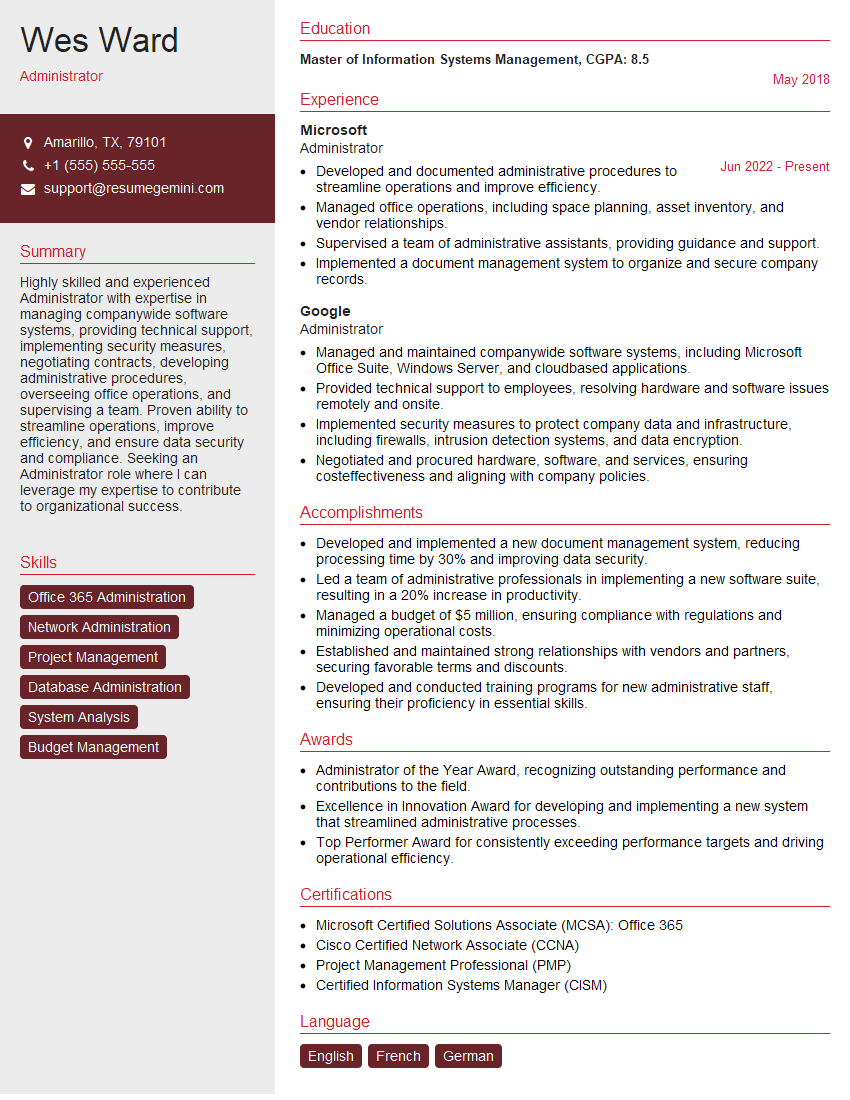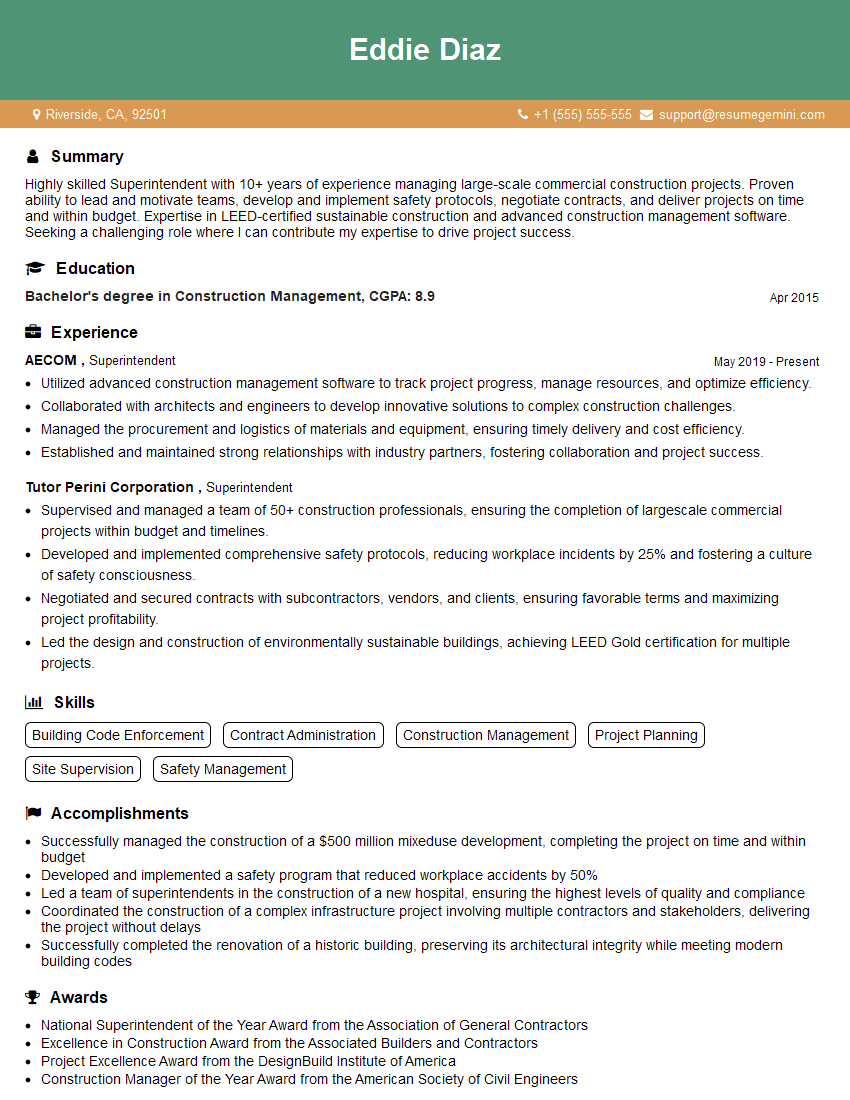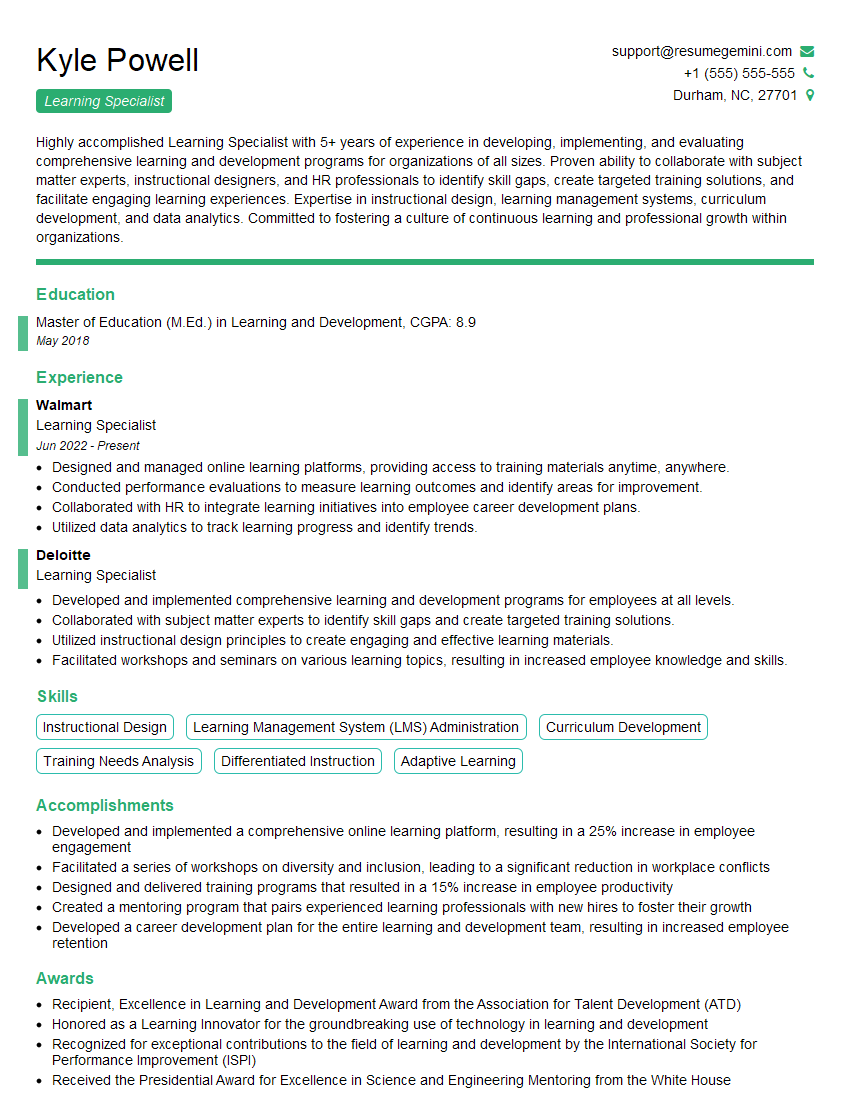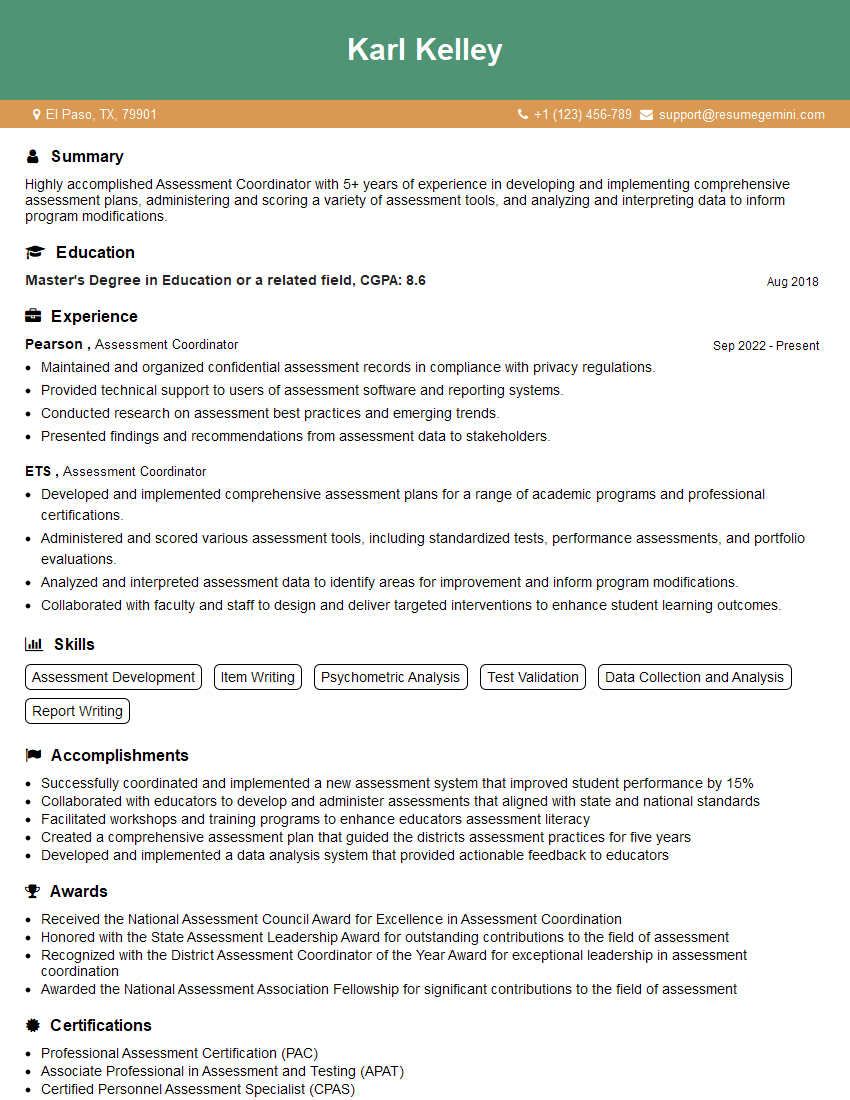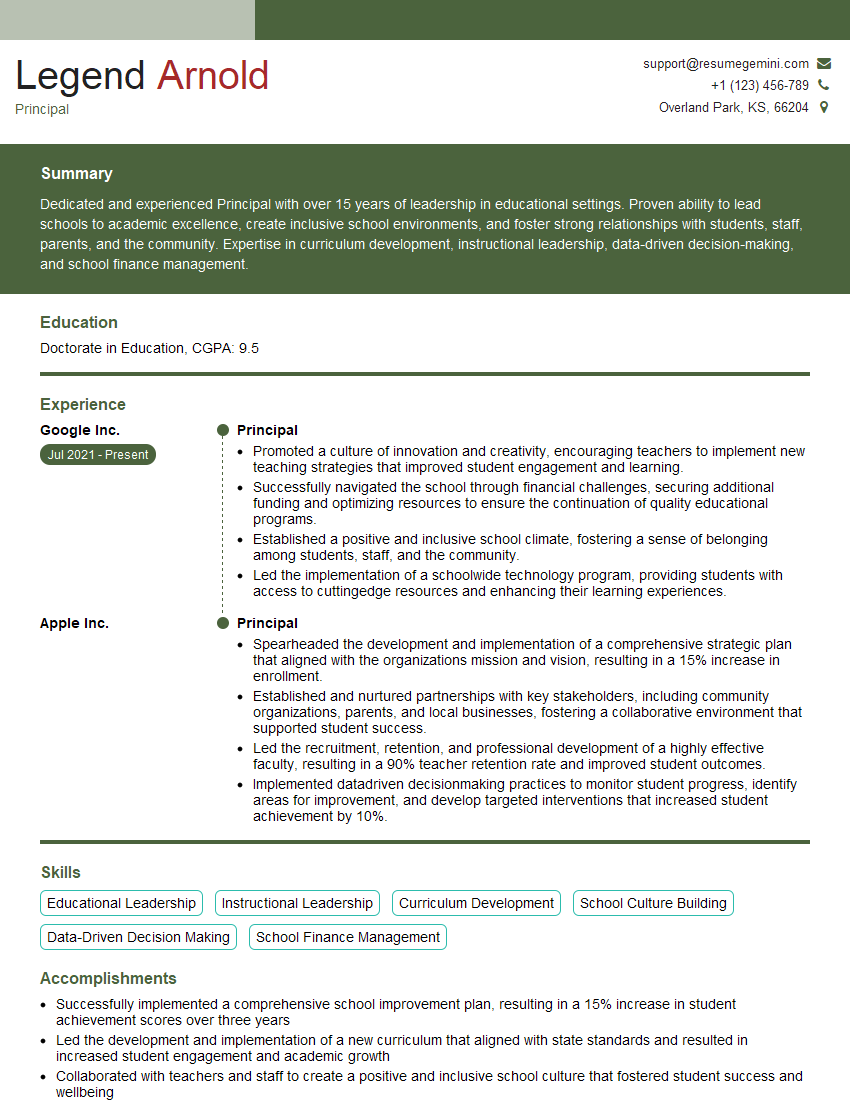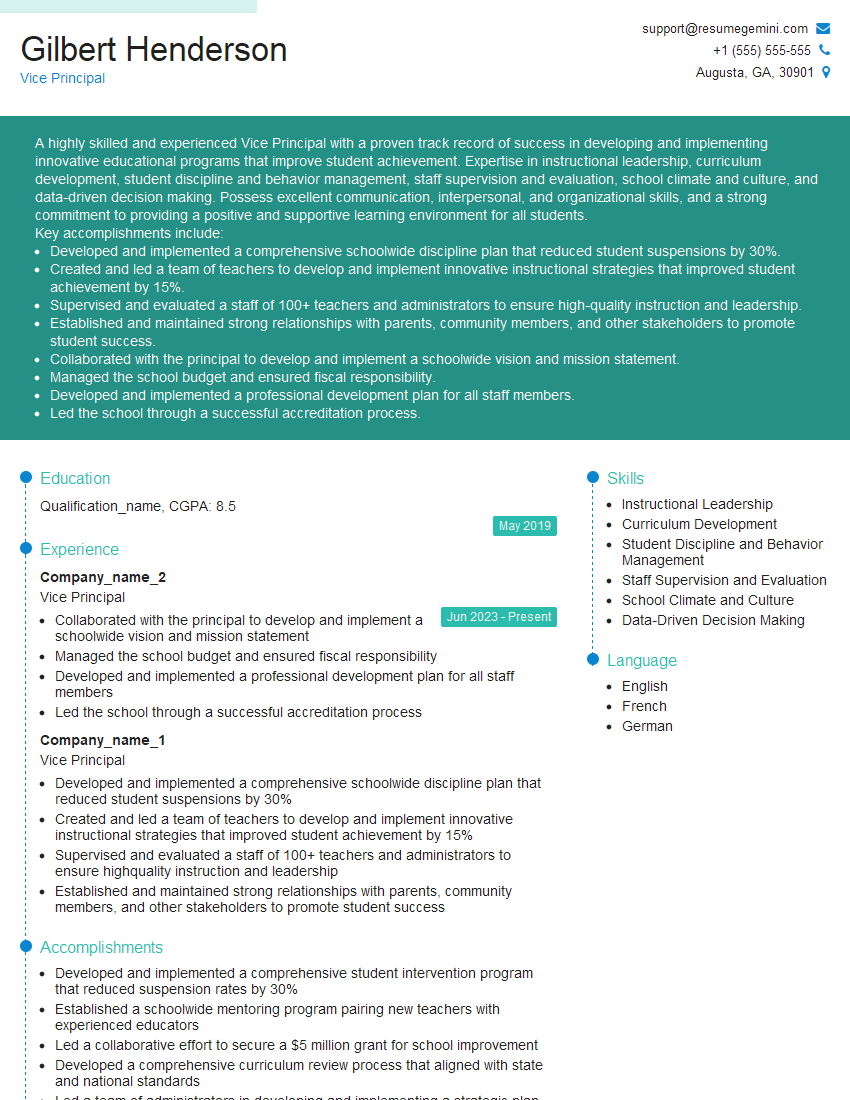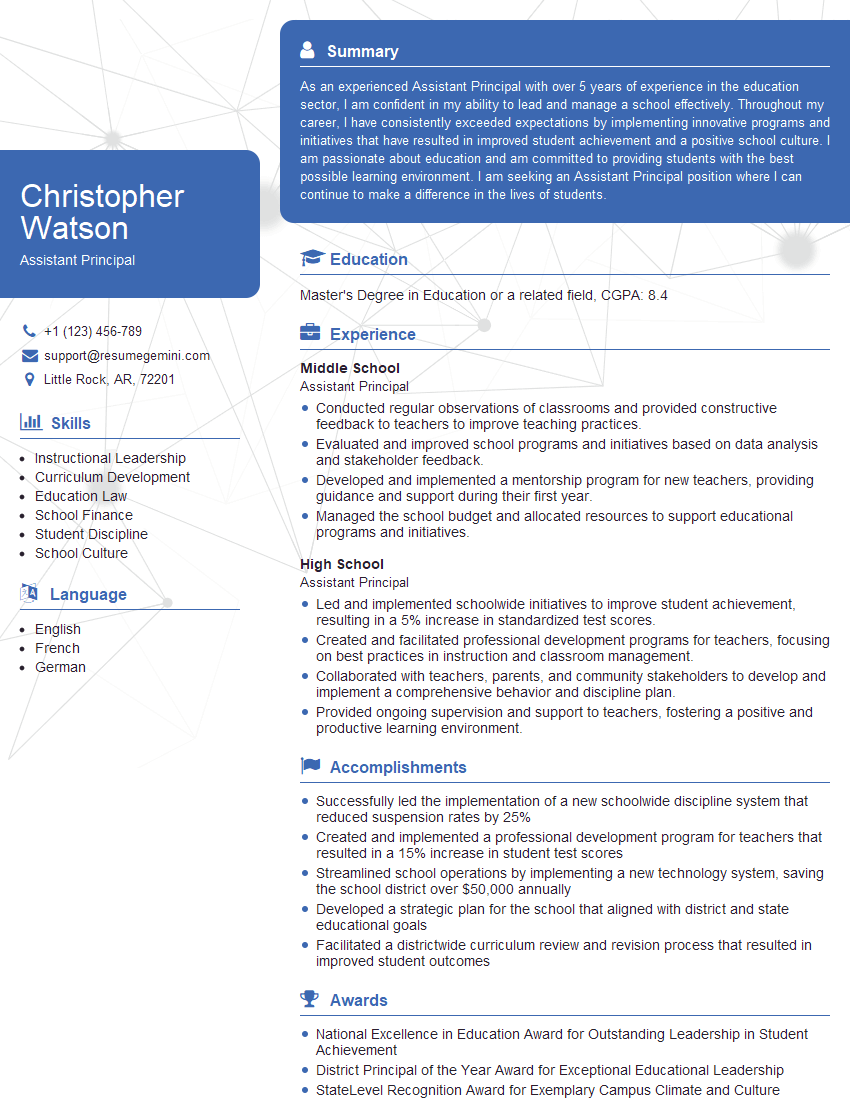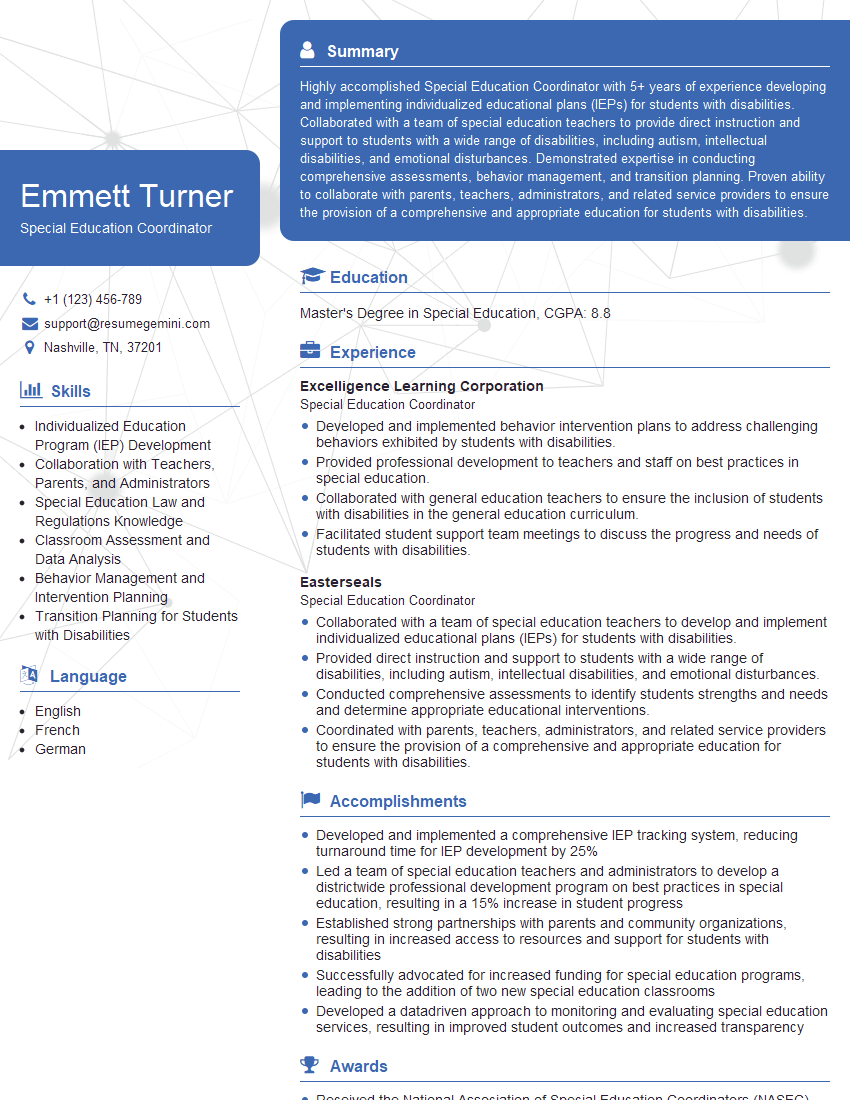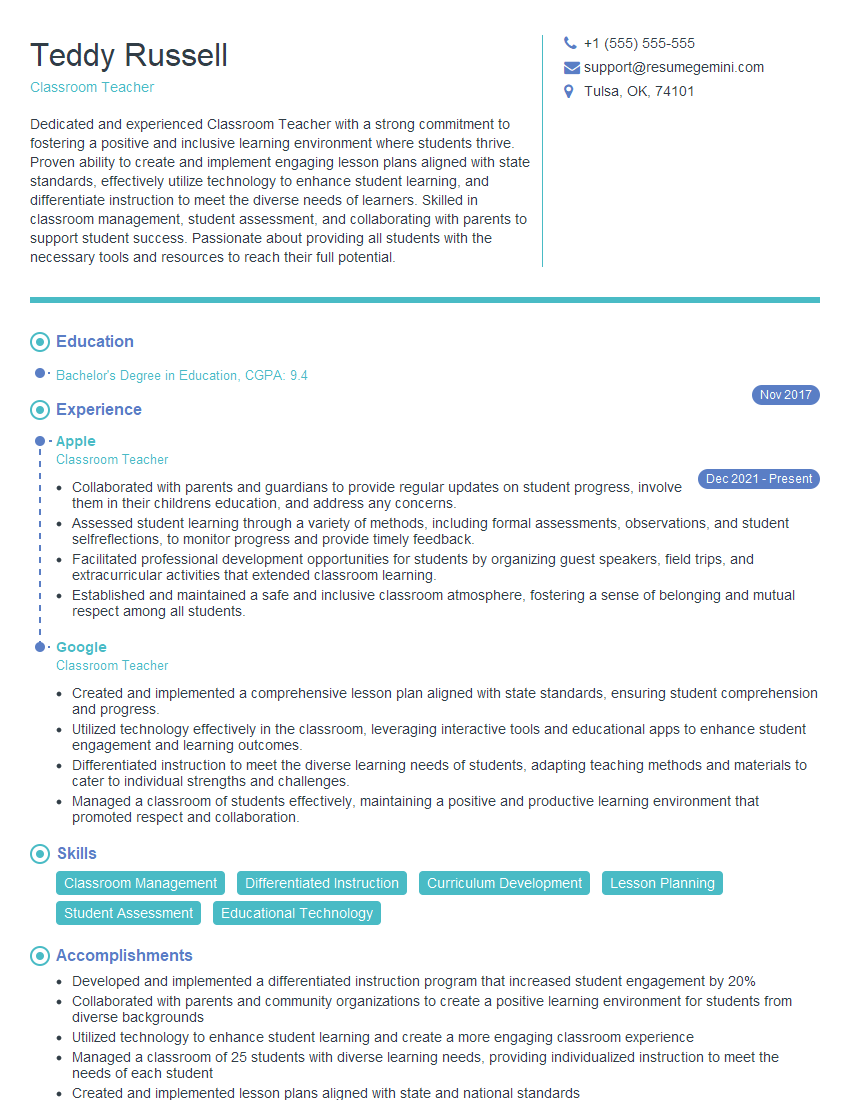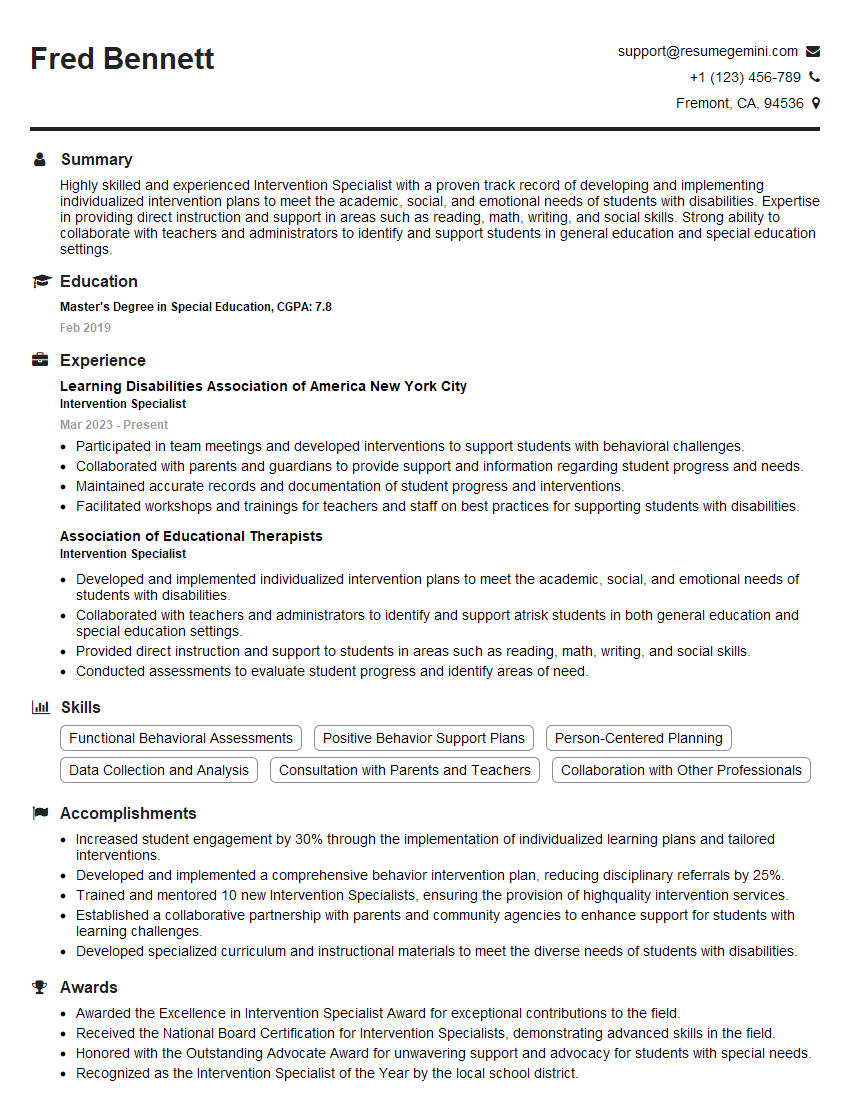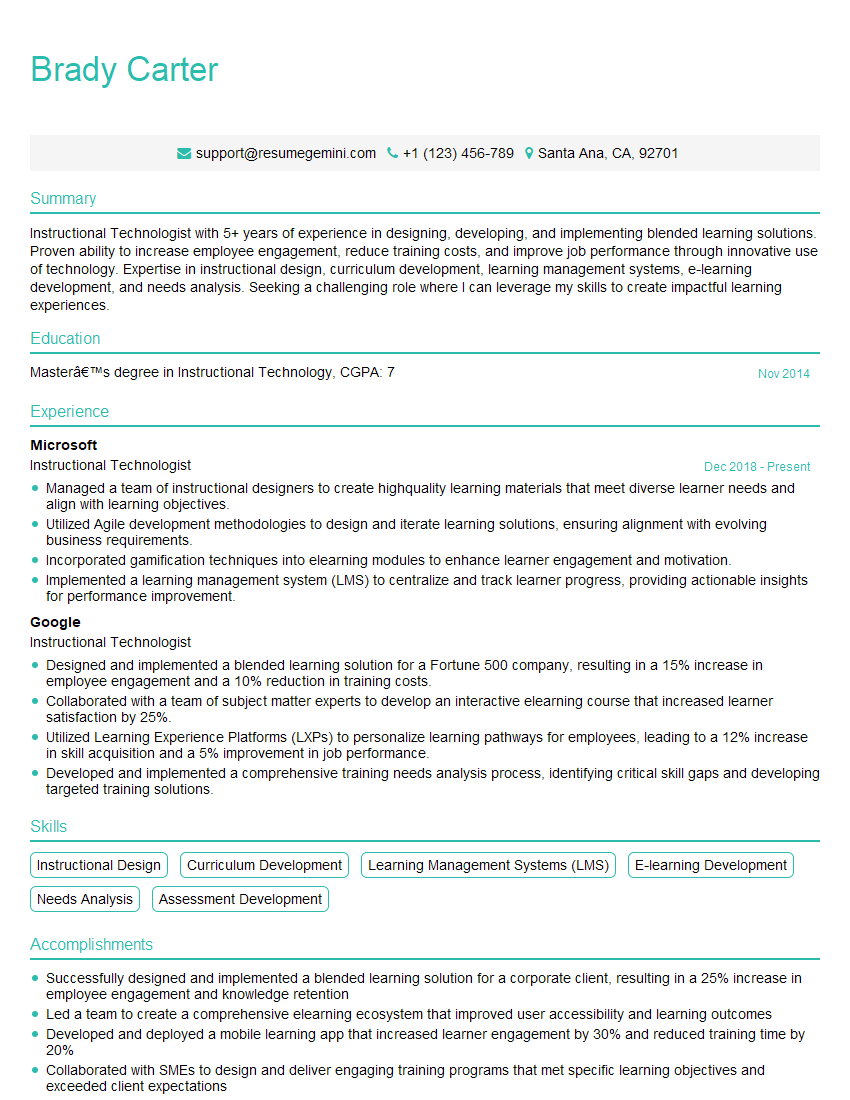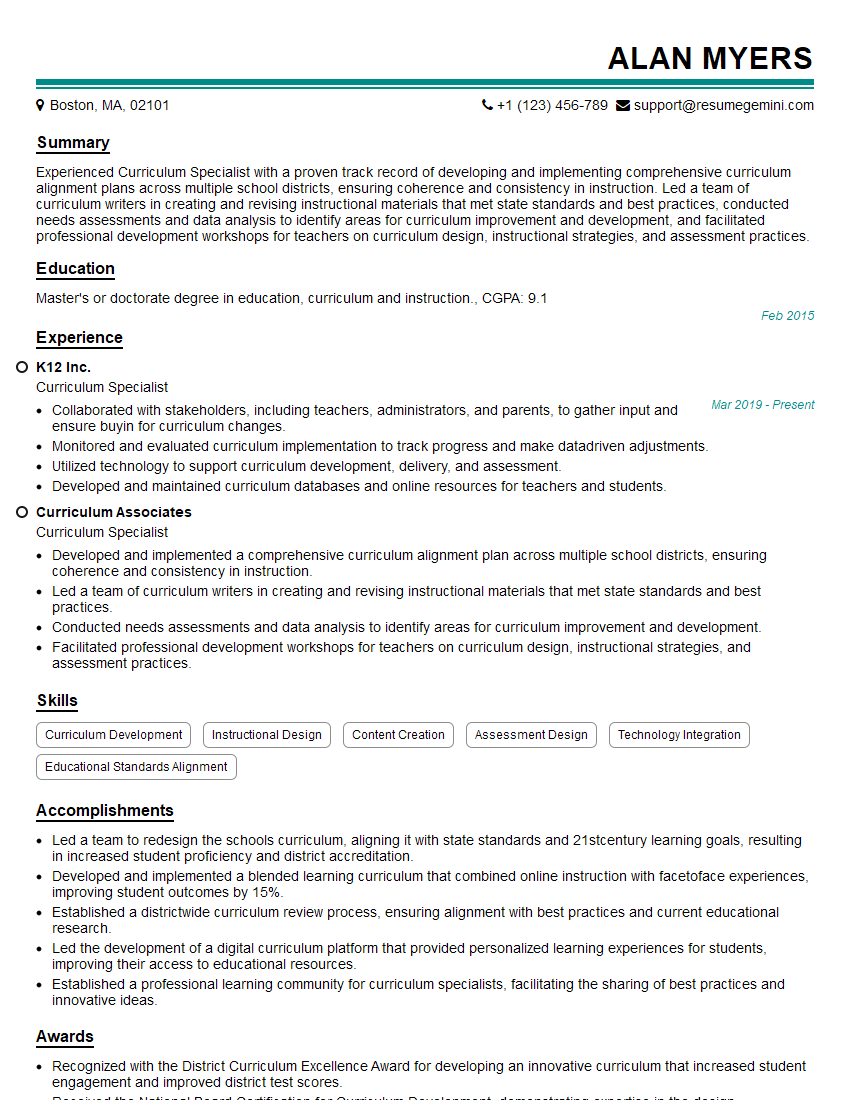Feeling uncertain about what to expect in your upcoming interview? We’ve got you covered! This blog highlights the most important Student-Led Conferences interview questions and provides actionable advice to help you stand out as the ideal candidate. Let’s pave the way for your success.
Questions Asked in Student-Led Conferences Interview
Q 1. Describe your experience facilitating Student-Led Conferences.
My experience with Student-Led Conferences (SLCs) spans over ten years, working with students from diverse academic backgrounds and learning styles. I’ve facilitated hundreds of SLCs, ranging from elementary school to high school levels. I’ve seen firsthand the transformative power of this approach, witnessing students blossom as they take ownership of their learning. My experience includes developing and implementing training programs for teachers on effective SLC facilitation, creating student-friendly presentation resources, and adapting the SLC process to meet the needs of individual students with IEPs or 504 plans. I’ve also actively participated in professional development workshops and conferences focused on best practices in student-led conferencing.
For example, in a recent high school SLC, a student effectively presented their progress in AP Calculus, showcasing their understanding of complex concepts through interactive demonstrations and problem-solving. This not only demonstrated their mastery of the subject but also showcased their confidence and communication skills.
Q 2. What are the key benefits of Student-Led Conferences for students?
Student-Led Conferences offer numerous benefits. For students, the most significant benefit is increased ownership of their learning. By preparing and presenting their work, students develop crucial self-assessment skills, identifying their strengths and areas for improvement. The process fosters communication and presentation skills, vital for success in all aspects of life. Additionally, SLCs build confidence and self-advocacy skills as students confidently share their accomplishments and discuss their learning journey with parents and teachers. Finally, it promotes a deeper understanding and engagement with their learning process itself.
- Increased self-awareness of learning progress
- Improved communication and presentation skills
- Enhanced self-confidence and self-advocacy
- Deeper understanding of learning goals and strategies
Q 3. How do you prepare students for a Student-Led Conference?
Preparing students for an SLC is a crucial step. I begin by teaching students how to effectively reflect on their work using specific criteria or rubrics. We collaboratively establish learning goals, track progress, and collect evidence of their learning. This might include samples of their work, reflection journals, or projects. We then practice presenting this information clearly and concisely. I often use role-playing to simulate the conference setting, allowing students to practice answering potential questions. The process isn’t just about presenting grades; it’s about showcasing their learning journey and growth mindset.
For example, I might guide students to create a visual representation of their progress using graphs or timelines, making their presentation more engaging and easier for parents to understand. We also practice handling potential questions with confidence and clarity. The key is making them comfortable, confident and well-prepared.
Q 4. What strategies do you use to ensure student participation in the SLC process?
Ensuring student participation is paramount. I emphasize that the SLC is their opportunity to share their learning story. I use a variety of strategies to encourage active participation. Firstly, I involve students in the planning process, allowing them to choose how they will present their work. This could include using multimedia presentations, artwork, or even hands-on demonstrations. I encourage them to personalize their presentations, reflecting their individual learning styles. I also provide positive reinforcement and celebrate their efforts and achievements throughout the preparation process.
For instance, I might offer choices within the presentation format, allowing a student who excels in art to showcase their understanding through a visual portfolio, while a student who is verbally strong can opt for a more discussion-based approach.
Q 5. How do you address situations where a student is unprepared for their SLC?
When a student is unprepared, I address the situation with empathy and understanding. I first try to identify the reasons for their lack of preparedness—time management issues, lack of understanding, or perhaps unforeseen circumstances. We then collaboratively develop a plan to get them back on track. This might involve setting smaller, achievable goals, providing extra support, or adjusting the scope of their presentation. The focus shifts to learning from the experience and developing better time management skills. The SLC might be postponed, or we might adjust the expectations to ensure the student feels supported and successful.
It’s important to avoid making the student feel shamed or judged. The goal is to use this as a learning opportunity, helping them develop better organizational and time management skills for future presentations and assignments.
Q 6. Explain your approach to providing feedback to students after an SLC.
Post-SLC feedback is crucial. I provide both verbal and written feedback, focusing on the student’s strengths and areas for improvement. I emphasize their effort and progress, celebrating successes while providing constructive suggestions for future development. This feedback is tailored to their individual presentation and learning process, avoiding generic comments. I also encourage self-reflection by asking students to reflect on their performance and identify areas they’d like to work on.
For example, feedback might include praising their clear explanation of a complex concept while suggesting they incorporate more visual aids to enhance engagement in future presentations. I always emphasize that feedback is a tool for growth and improvement.
Q 7. How do you involve parents in the Student-Led Conference process?
Parent involvement is crucial for the success of SLCs. I communicate with parents throughout the process, explaining the purpose and benefits of SLCs. I provide resources and guidance on how they can support their child’s preparation. This might involve sharing sample presentations or providing access to online resources. I also invite parents to actively participate in the conference, encouraging them to ask questions and engage in a collaborative discussion about the student’s progress. Clear communication and a collaborative approach ensure parents understand the process and can effectively support their child’s learning journey.
For instance, I might send a preparatory email outlining the conference format, providing parents with questions they can ask, and suggesting ways they can engage in the discussion productively.
Q 8. How do you differentiate the SLC process for students with diverse learning needs?
Differentiation in Student-Led Conferences (SLCs) for students with diverse learning needs is crucial for ensuring inclusivity and showcasing each student’s unique progress. It’s not about changing the core SLC process, but adapting the presentation and support offered.
- Modified Presentation: For students with visual impairments, providing large-print materials or audio recordings of their work is vital. Students with auditory processing challenges might benefit from visual aids or written summaries alongside oral presentations. Students with physical limitations may need adjusted presentation formats, perhaps using assistive technology or a modified presentation style.
- Adjusted Support Systems: Some students might require a peer buddy to help with presentation logistics or answer questions. Others might need pre-conference practice sessions with an educator or support staff to build confidence and ensure they feel prepared. Clear communication with parents/guardians beforehand to explain the accommodations is also key.
- Individualized Goals: Focus on celebrating the student’s progress relative to their Individualized Education Program (IEP) or 504 plan, rather than solely comparing them to their peers. This emphasizes growth and effort, fostering a positive and encouraging SLC experience.
For example, a student with autism might present their work through a visual schedule they’ve created, highlighting their achievements and next steps. A student with ADHD might use a structured presentation with bullet points to maintain focus and stay on track. The key is to celebrate their unique strengths and learning journey.
Q 9. What assessment tools do you use to inform the content of an SLC?
Assessment tools informing the content of an SLC are varied and should reflect the student’s learning goals and the subjects covered. The goal is to showcase student learning, not just grades. We strive for a holistic approach.
- Student Self-Assessment: Students reflect on their strengths and areas for growth using checklists, rubrics, or journals. This promotes metacognition and ownership of learning.
- Work Samples: Students showcase their best work, demonstrating skills and progress across various projects or assignments. This could include writing samples, artwork, problem-solving solutions, or science experiments.
- Anecdotal Records: Teachers use notes documenting observations of student behavior, effort, collaboration, and problem-solving skills. This provides valuable context beyond grades.
- Standardized Assessments: Data from standardized tests can offer a broader view of student achievement in comparison to peers, though this should be presented thoughtfully, focusing on growth and areas for improvement rather than just scores.
- Project-Based Learning Evidence: If the curriculum includes project-based learning, the process and final product serve as valuable assessment tools, demonstrating critical thinking, collaboration, and problem-solving abilities.
The selection of tools depends on the student’s age, learning style, and the specific subject areas being discussed. It’s important to involve students in selecting the evidence they’ll share, empowering them to showcase their accomplishments.
Q 10. How do you ensure the SLC process aligns with school-wide learning goals?
Aligning SLCs with school-wide learning goals is crucial for maintaining consistency and reinforcing the school’s overall educational philosophy. This ensures that the SLCs don’t become isolated events, but rather integral components of the school’s broader assessment and communication strategy.
- Curriculum Mapping: Closely examine the curriculum to identify key skills and competencies expected at each grade level. These should be reflected in the students’ chosen work samples and presentations.
- Shared Learning Objectives: Ensure that the criteria for success in SLC presentations aligns with the school’s assessment rubrics and grading standards. This provides clear benchmarks for student achievement.
- Teacher Collaboration: Teachers should collaborate to ensure consistency in expectations and assessment criteria across different subjects and grade levels. This avoids conflicting messages and promotes a unified approach to learning.
- Feedback Loops: The SLC process itself provides valuable feedback for refining the curriculum and teaching methods. Analysis of student work and presentations can reveal areas where adjustments to teaching strategies are needed.
For example, if the school emphasizes critical thinking skills, SLCs should showcase students’ ability to analyze information, solve problems, and make reasoned judgments. The emphasis should be on aligning student presentations with the school’s overall vision for student learning and development.
Q 11. Describe a time you had to adapt an SLC to meet a student’s specific needs.
I once had a student, Maria, who was extremely anxious about public speaking. While she was a bright and capable student, the thought of presenting her work to her parents and me filled her with dread. To adapt the SLC to her needs, we implemented several strategies:
- Practice Sessions: We scheduled several short practice sessions where Maria could present her work to me in a low-pressure environment. This helped her gain confidence and refine her presentation skills.
- Visual Aids: We created a visually appealing presentation with key points and images to supplement her oral presentation, reducing her reliance on memorization and allowing her to focus on conveying her understanding.
- Structured Format: We developed a structured format for the presentation, outlining specific points to discuss, which helped her stay on track and reduce anxiety.
- Pre-Conference Meeting: We held a short pre-conference meeting with her parents to discuss the accommodations and explain the process. This ensured they understood and could provide support and encouragement.
Maria’s SLC was ultimately a success. By adapting the process to accommodate her anxiety, she was able to showcase her hard work and understanding, fostering a positive learning experience. The key was to focus on her individual needs and create an environment where she felt comfortable and empowered.
Q 12. What are some common challenges associated with Student-Led Conferences, and how do you address them?
Some common challenges associated with SLCs include:
- Student Anxiety: Some students may be apprehensive about presenting their work. Addressing this requires providing ample preparation time, practice opportunities, and supportive feedback.
- Time Constraints: Allocating sufficient time for each SLC can be challenging. Careful planning and scheduling are essential.
- Parental Involvement: Ensuring active parental participation requires clear communication and collaboration. Pre-conference communication and clear guidelines can help address this.
- Assessment Consistency: Maintaining consistency in assessment across different students and subjects is important. Clear rubrics and guidelines for student presentations are crucial.
- Technology Issues: Technical glitches can disrupt the flow of the SLC. Having backup plans and ensuring technological proficiency is vital.
We address these challenges through proactive planning, clear communication with parents and students, providing ample support and resources, and employing effective time management techniques. Regular reflection on the process also allows for continuous improvement.
Q 13. How do you use technology to enhance the Student-Led Conference experience?
Technology can significantly enhance the SLC experience. It provides opportunities for creative presentations and efficient communication.
- Digital Presentations: Students can use presentation software like PowerPoint or Google Slides to create engaging visual aids, incorporating multimedia elements like videos and images.
- Interactive Whiteboards: Interactive whiteboards allow for dynamic presentations and collaborative discussions.
- Online Portfolios: Students can showcase their work through online portfolios, allowing parents to view projects and assignments remotely.
- Video Conferencing: For families who cannot attend in person, video conferencing can facilitate participation.
- Learning Management Systems (LMS): Platforms like Google Classroom or Canvas can be used to share resources, assign tasks, and facilitate communication between students, teachers, and parents.
Technology should be used thoughtfully, ensuring it complements rather than overshadows the core purpose of the SLC – celebrating student achievement and fostering communication.
Q 14. What are the key differences between traditional parent-teacher conferences and Student-Led Conferences?
The key difference between traditional parent-teacher conferences and SLCs lies in the student’s role. In traditional conferences, the teacher primarily leads the discussion, presenting information about the student’s progress. In SLCs, the student is the primary presenter, taking ownership of their learning journey and demonstrating their understanding.
- Student Agency: SLCs empower students to reflect on their learning, identify their strengths and weaknesses, and set goals for improvement.
- Communication Style: SLCs promote a more collaborative and conversational approach, with the student, teacher, and parents working together to support the student’s learning.
- Focus: While traditional conferences might emphasize grades and standardized assessments, SLCs focus on a broader range of evidence showcasing student progress, including work samples, projects, and self-reflection.
- Assessment: Traditional conferences rely heavily on the teacher’s assessment, while SLCs incorporate student self-assessment and provide opportunities for the student to share their perspective on their progress.
In essence, SLCs shift the focus from a teacher-centric to a student-centric model, promoting student agency and fostering a more collaborative partnership between the student, teacher, and parents.
Q 15. How do you measure the effectiveness of your Student-Led Conferences?
Measuring the effectiveness of Student-Led Conferences (SLCs) requires a multi-faceted approach. We can’t rely on a single metric, but rather a combination of qualitative and quantitative data.
- Student Self-Reflection Surveys: Post-SLC, students complete surveys assessing their comfort level, learning about their progress, and contribution to the conference. This provides valuable insights into their perspective.
- Parent Feedback Forms: Similar surveys are given to parents, gauging their satisfaction with the process, clarity of information received, and feeling of partnership established.
- Teacher Observation & Reflection: I meticulously record observations during the SLCs, noting student confidence, communication skills, and the quality of their self-assessment. Post-conferences, I reflect on what worked well and areas for improvement.
- Analysis of Student Academic Performance: While not a direct measure of the SLC itself, we observe if SLCs correlate with improved student engagement and academic progress over time. This is a longer-term evaluation.
- Focus Groups: Conducting focus groups with students, parents, and teachers can offer rich qualitative data and identify common themes and areas for improvement.
By combining these data points, we build a comprehensive picture of the SLC’s impact and refine the process continually.
Career Expert Tips:
- Ace those interviews! Prepare effectively by reviewing the Top 50 Most Common Interview Questions on ResumeGemini.
- Navigate your job search with confidence! Explore a wide range of Career Tips on ResumeGemini. Learn about common challenges and recommendations to overcome them.
- Craft the perfect resume! Master the Art of Resume Writing with ResumeGemini’s guide. Showcase your unique qualifications and achievements effectively.
- Don’t miss out on holiday savings! Build your dream resume with ResumeGemini’s ATS optimized templates.
Q 16. How do you build rapport and trust with students during the preparation for an SLC?
Building rapport and trust with students is crucial for a successful SLC. It begins well before the conference itself. I foster this through:
- Regular Classroom Interactions: Creating a supportive and inclusive classroom environment where students feel safe to express themselves is paramount. Open communication and active listening are key.
- Early Introduction & Practice: I introduce the concept of SLCs well in advance, explaining the process and purpose clearly. We begin with practice sessions, allowing students to present aspects of their work in a low-stakes environment.
- Collaborative Goal Setting: Students actively participate in defining the learning goals and choosing the evidence they’ll showcase. This gives them ownership of the process.
- Individualized Support: I provide individualized guidance to each student, helping them select appropriate evidence and articulate their learning journey. This might involve one-on-one practice sessions, providing feedback, and offering constructive criticism.
- Positive Reinforcement: I focus on celebrating students’ achievements and strengths, creating a positive and encouraging atmosphere.
For example, I might start a session by saying, “Let’s work together to make sure your presentation showcases your best work and tells your learning story.”
Q 17. How do you ensure that the SLC is a collaborative effort between the student, parent, and teacher?
The SLC is designed to be a truly collaborative effort. I ensure this by:
- Student Leadership: The student is the central figure, leading the conversation and sharing their work. This empowers them and reinforces their role as active learners.
- Teacher Facilitation: I act as a facilitator, guiding the conversation, clarifying points, and offering additional context when needed. I avoid dominating the discussion.
- Parent Partnership: Parents are active participants, asking questions, offering insights, and collaborating with the student and teacher to set future goals. I encourage them to view this as a team effort.
- Structured Agenda: A structured agenda with clear time allocations helps maintain focus and ensures all stakeholders have opportunities to participate.
- Pre-Conference Communication: Prior communication outlining the structure and purpose of the SLC ensures everyone comes prepared and understands their roles.
For instance, I might begin by saying, “This conference is a team effort – let’s work together to understand [student’s name]’s progress and plan for their future success.”
Q 18. Describe your process for selecting appropriate evidence for an SLC.
Selecting appropriate evidence is critical. It should be a representative sample of the student’s work that clearly demonstrates their learning progress, strengths, and areas for growth. I use the following process:
- Alignment with Learning Goals: The evidence should directly reflect the learning objectives and goals for the reporting period. This ensures that the SLC provides a clear picture of the student’s progress towards those goals.
- Variety of Evidence: I encourage students to showcase a range of evidence, including written work, projects, presentations, artwork, and self-reflections. This provides a holistic view of their learning.
- Student Choice & Input: Students are given considerable input in selecting the evidence they wish to present. This fosters ownership and allows them to highlight their best work.
- Teacher Guidance & Feedback: I offer guidance and feedback to ensure the chosen evidence is appropriate, relevant, and effectively communicates their learning journey.
- Focus on Growth and Progress: The selected evidence should showcase not only achievements but also the learning process, challenges overcome, and areas for future development.
For example, a student might choose a piece of writing demonstrating improved grammar skills, a science project showcasing their experimental design, and a self-reflection detailing their growth in problem-solving.
Q 19. How do you handle sensitive topics or difficult conversations during an SLC?
Handling sensitive topics or difficult conversations requires empathy, tact, and a collaborative approach. I employ the following strategies:
- Create a Safe & Supportive Environment: Establishing a trusting relationship with both the student and parent is crucial. I emphasize that the SLC is a safe space for open and honest communication.
- Active Listening & Empathy: I listen carefully to all viewpoints and show empathy for any concerns or challenges raised. This creates space for constructive dialogue.
- Collaborative Problem-Solving: We work together – student, parent, and teacher – to brainstorm solutions and develop strategies for addressing any issues raised.
- Focus on Solutions & Next Steps: Instead of dwelling on past problems, the conversation focuses on solutions, developing action plans, and setting achievable goals for the future.
- Confidentiality & Boundaries: I maintain confidentiality and respect professional boundaries, ensuring all conversations remain appropriate and respectful.
If needed, I may suggest follow-up meetings with individual stakeholders to address sensitive issues in more depth.
Q 20. What strategies do you employ to ensure that all stakeholders understand the goals of the SLC?
Ensuring all stakeholders understand the goals of the SLC requires clear and consistent communication from the outset.
- Informative Introductory Sessions: I conduct introductory sessions for parents and students, clearly explaining the purpose, format, and benefits of SLCs.
- Written Materials: I provide written materials, such as a detailed explanation of the process and frequently asked questions (FAQs), to reinforce understanding.
- Modeling & Demonstration: Modeling a sample SLC or showing examples of student presentations can be helpful in illustrating the process.
- Open Communication Channels: I establish clear communication channels for parents and students to ask questions or express concerns.
- Consistent Messaging: I ensure consistent messaging across all communication channels, reinforcing the key goals and benefits of SLCs.
By emphasizing the collaborative nature of SLCs and the focus on student growth and progress, I ensure that everyone understands the shared goals.
Q 21. How do you communicate effectively with parents about the SLC process?
Effective communication with parents about the SLC process is essential for success. My strategy includes:
- Initial Introductory Letter/Email: A clear and concise initial communication outlines the purpose, date, time, and format of the SLCs, along with any preparation required from parents.
- Regular Updates & Reminders: Regular updates and reminders leading up to the conferences keep parents informed and prepared.
- Accessible Information: I provide easy access to information via school website, email, or handouts, including FAQs and useful resources.
- Personalized Communication: Where necessary, I provide personalized communication to address individual parent’s questions or concerns.
- Post-SLC Follow-Up: A brief follow-up communication summarizes key discussion points and outlines agreed-upon next steps.
By using a multi-channel approach and tailoring communication to individual needs, I ensure that all parents are well-informed and engaged in the SLC process.
Q 22. What are some effective ways to maintain student engagement throughout the SLC?
Maintaining student engagement during a Student-Led Conference (SLC) is crucial for its success. It’s about making the process interactive and meaningful for the student, showcasing their learning journey, not just presenting a report card.
- Interactive Presentations: Encourage students to use diverse methods beyond just reading from notes. Think slideshows, posters, demonstrations, or even short performances showcasing their projects. For example, a student studying ecosystems might create a miniature diorama to explain their understanding.
- Student-Chosen Focus: Allow students to select the aspects of their learning they wish to highlight. This gives them ownership and increases their enthusiasm. A student might focus on their progress overcoming a particular challenge, rather than only on their grades.
- Incorporating Multimedia: Using visuals, audio clips, or short videos helps keep the conference dynamic. For instance, a student learning a new language could include audio recordings of themselves speaking.
- Hands-on Activities: If possible, include small, interactive activities that demonstrate their learning. This could be a quick math problem, a short writing exercise related to a book they read, or a science experiment they’ve performed.
- Audience Participation: Encourage questions and discussion, turning the conference into a collaborative dialogue, rather than a one-way presentation. This allows students to clarify points and receive immediate feedback.
Q 23. How do you balance student autonomy with appropriate teacher guidance during the SLC?
Balancing student autonomy with teacher guidance is a delicate act in SLCs. The goal is to empower the student to lead the conference, while providing appropriate support and structure to ensure success. It’s like teaching a child to ride a bike – you provide support initially, then gradually let go as they gain confidence.
- Pre-Conference Planning: Provide clear guidelines and a framework for the student’s presentation. This might include a template, suggested topics, and a practice session. This ensures the student is prepared and on track, but allows them to choose what details they include.
- Active Listening and Support: During the conference, act as a facilitator, offering gentle guidance and support when needed, rather than dominating the conversation. Use prompts like, “Tell me more about that.” or “How did you approach this challenge?” to guide the discussion without taking control.
- Reflection and Feedback: After the student’s presentation, offer constructive feedback, focusing on both strengths and areas for improvement. Discuss the process itself, not just the content. For instance, you could suggest improvements for organization or delivery for the next time.
- Gradual Increase in Autonomy: Adjust the level of support based on the student’s maturity and experience with SLCs. As students participate in more conferences, they’ll develop greater confidence and require less direct intervention.
Q 24. How do you use data from the SLC to inform future instruction?
Data from SLCs provide invaluable insights to inform future instruction. It’s more than just grades; it’s about understanding the student’s learning process, strengths, and challenges.
- Identifying Learning Gaps: Pay close attention to areas where students struggled or expressed confusion during their presentations. This directly pinpoints areas needing further instruction or different teaching strategies.
- Adjusting Instructional Strategies: If multiple students struggled with a similar concept, it indicates a need to revise teaching methods. For example, if several students struggled with a specific math problem, perhaps a different explanation or a hands-on activity would be more effective.
- Differentiation of Instruction: SLCs help identify individual learning styles and needs. This allows educators to tailor instruction to meet diverse learning preferences, providing support for struggling learners and enrichment for those who excel.
- Curriculum Alignment: Data collected from SLCs can highlight gaps between the curriculum and student understanding. It provides valuable feedback for improving curriculum design and ensuring it aligns with student needs and learning goals.
- Formative Assessment: SLCs serve as a powerful formative assessment tool, providing real-time feedback that guides instructional decisions. It allows for adjustments throughout the learning process, rather than solely relying on summative assessments.
Q 25. What professional development have you sought to improve your skills in facilitating Student-Led Conferences?
To enhance my SLC facilitation skills, I’ve engaged in various professional development opportunities, focusing on both the theoretical and practical aspects of student-led conferences.
- Workshops and Seminars: I’ve attended workshops focused on effective communication, active listening skills, and providing constructive feedback. These workshops often include practical simulations and role-playing scenarios to build confidence.
- Mentorship Programs: I’ve sought mentorship from experienced educators who are proficient in facilitating SLCs. Observing their sessions and discussing best practices has been invaluable. This hands-on learning has significantly improved my own facilitation skills.
- Online Courses and Resources: I’ve explored online courses and professional development modules on student-centered learning, assessment strategies, and effective conferencing techniques. These resources often provide practical tools and templates for improving SLCs.
- Collaborative Planning: Regular meetings with colleagues to share strategies, resources, and challenges related to SLCs are crucial for continuous improvement and sharing best practices. The collaborative aspect offers diverse perspectives and practical solutions.
Q 26. How do you promote a positive and supportive learning environment during an SLC?
Creating a positive and supportive learning environment during an SLC is paramount. It should be a celebration of the student’s learning journey, not a judgment.
- Positive and Encouraging Language: Using phrases like, “Tell me about your proudest accomplishment.” or “What are you most excited about in your learning?” sets a positive tone. Focus on strengths and progress, not just deficits.
- Non-judgmental Atmosphere: Create a safe space where students feel comfortable sharing their learning experiences, even if they involve challenges or mistakes. Emphasize growth and progress over perfection.
- Active Listening and Empathy: Demonstrate genuine interest in the student’s learning by actively listening to their presentation and showing empathy for their challenges. This makes the student feel valued and understood.
- Celebrating Accomplishments: Acknowledge and celebrate the student’s achievements, both big and small. This reinforces their efforts and boosts their confidence.
- Collaboration and Partnership: Frame the conference as a collaborative effort between the student, parent/guardian, and teacher, working together to support the student’s learning journey.
Q 27. What are your strategies for managing time effectively during an SLC?
Effective time management is essential for successful SLCs. Pre-planning and clear structure are key to ensuring the conference stays on track.
- Pre-Conference Scheduling: Establish a clear timeframe for each conference, and communicate this to students and parents/guardians in advance. A 15-20 minute time slot is usually sufficient for elementary students, with longer times needed for older students.
- Structured Agenda: Provide a simple agenda or framework for the student to follow during their presentation. This keeps the conference focused and prevents it from straying off-topic.
- Time Signals: Use subtle time signals to help the student stay on track. A simple glance at the clock or a gentle reminder can be effective without interrupting the flow.
- Prioritize Key Information: Encourage students to focus on their key learning achievements and areas for improvement. This helps them prioritize the most important information within the allocated time.
- Efficient Questioning Techniques: Use open-ended questions that encourage detailed responses, but avoid lengthy lines of questioning that could consume valuable time. Focus questions on the student’s reflection and understanding of their learning.
Key Topics to Learn for Student-Led Conferences Interview
- Understanding the Student Perspective: Explore effective strategies for eliciting meaningful student participation and fostering open communication during conferences. Consider different learning styles and communication needs.
- Data-Driven Discussions: Learn how to effectively utilize student data (grades, assessments, projects) to illustrate progress, identify areas for improvement, and collaboratively set future goals. Practice presenting data clearly and concisely.
- Goal Setting & Action Planning: Master techniques for collaboratively developing achievable goals with students and parents. Practice outlining concrete steps and strategies for achieving those goals. Consider long-term academic and personal growth.
- Effective Communication & Collaboration: Develop strategies for communicating complex information clearly and concisely to parents and guardians with varying levels of educational background. Practice active listening and collaborative problem-solving.
- Addressing Challenges & Concerns: Prepare strategies for addressing potential challenges or concerns raised by students or parents, focusing on solutions and positive outcomes. Practice tactful and empathetic communication.
- Technology Integration: Explore how technology can enhance the Student-Led Conference experience, such as using digital portfolios, presentation tools, or online communication platforms. Consider accessibility and inclusivity.
- Ethical Considerations & Confidentiality: Understand the ethical considerations surrounding student data and maintain confidentiality throughout the conference process.
Next Steps
Mastering Student-Led Conferences demonstrates valuable skills in communication, collaboration, and data analysis – highly sought-after qualities in many education and related fields. A strong resume showcasing these skills is crucial for maximizing your job prospects. Building an ATS-friendly resume is key to getting your application noticed. ResumeGemini is a trusted resource to help you craft a professional and effective resume. We provide examples of resumes tailored to Student-Led Conferences to give you a head start. Take advantage of these resources to present yourself effectively and land your dream role.
Explore more articles
Users Rating of Our Blogs
Share Your Experience
We value your feedback! Please rate our content and share your thoughts (optional).
What Readers Say About Our Blog
Hi, I’m Jay, we have a few potential clients that are interested in your services, thought you might be a good fit. I’d love to talk about the details, when do you have time to talk?
Best,
Jay
Founder | CEO
